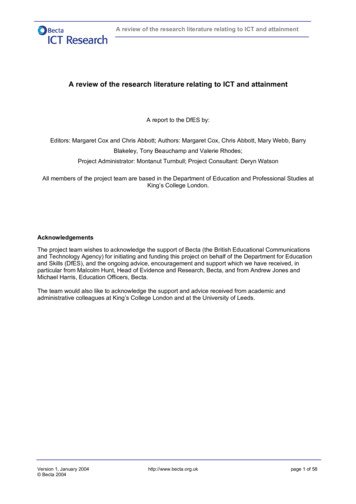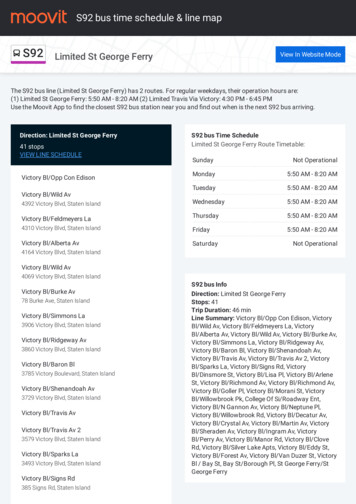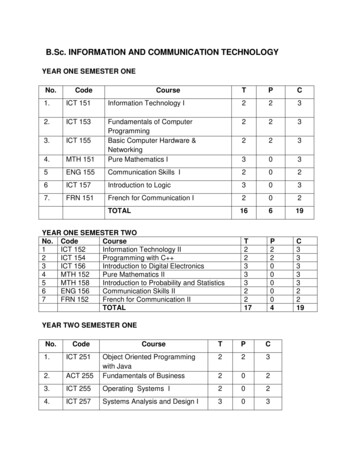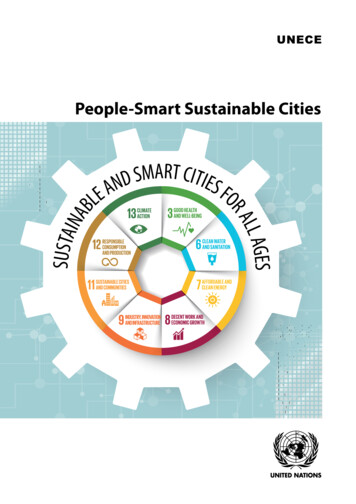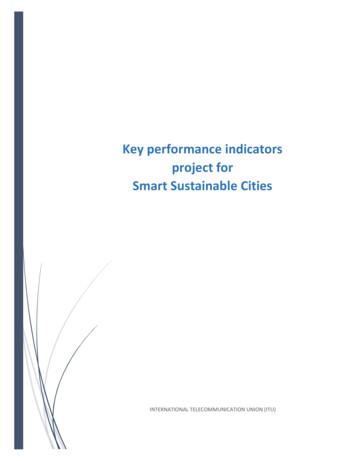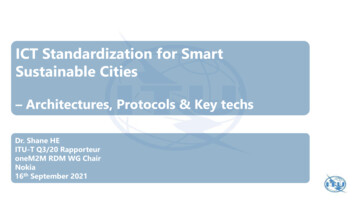
Transcription
ICT Standardization for SmartSustainable Cities– Architectures, Protocols & Key techsDr. Shane HEITU-T Q3/20 RapporteuroneM2M RDM WG ChairNokia16th September 2021
ITU-T SG20 Structure
Q3/20: Architectures, management, protocols and Quality of ServiceScopeThis Question addresses IoT functional architectures, protocols, management mechanisms, and QoS (includingperformance) of IoT and Smart Sustainable Cities and Communities (SC&C), which needed to constructarchitectural frameworks for the following reasons: to control network attachment procedures (including mobility management); to control session establishment and release, to control network resources (including QoS control); to interact with services and applications and to interact with legacy networks, etc.Main TasksDeveloping Recommendations, Reports, Handbooks, Guidelines, etc. as appropriate on: Conducting studies on general reference models on IoT and vertical industry needs; Developing frameworks to identify the basic architectural compositions and views on IoT; Determining the requirements that the connectivities and protocols are intended to support; Identifying performance requirements of connectivity technologies that will enable them to meet the IoT requirements; Identifying mechanisms for achieving QoS and its measurement principles required for IoT and SC&C; Identifying interfaces for interoperability between different IoT network elements; Defining interworking with legacy systems; Developing intelligence control related technologies that will provide support to IoT applications and services for various verticalsand systems; Identifying mechanisms for achieving architectural interoperability for IoT and SC&C; Providing the necessary collaboration for joint activities in this field within ITU and between ITU-T and SDOs, consortia and fora.More details in: /20/Pages/q3.aspx
Q3/20 main progressApproved Recommendations (2015-2016)Approved Recommendations (2017-2021)
Approved Recommendations Y.4500 (2017-2021)Approved TRs (2017-2021)
Q3/20 main activitiesOngoing WIsWITimeProcess ional architecture of AI enabled device-edge-cloud collaborative servicesfor IoT and smart cityReference architecture of collaborative decentralized machine learning forintelligent IoT servicesFunctional architecture of cellular-radio network capability exposure for smarthospital based on Internet of thingsDecentralized IoT communication architecture based on information centricnetworking and blockchainProtocols of supporting autonomic operations in the Internet of thingsCapability and functional architecture of peer of blockchain of thingsFramework of decentralized service by using DLT and edge computingtechnologies for IoT devicesReference architecture of service exposure for decentralized services for IoTapplicationsReference architecture of accessing IoT resources for management and controlRequirements and functional architecture for smart construction site servicesRequirements and functional architecture of IoT sensing quality managementservice
Q3/20 main activitiesOngoing WIsWITimeProcess ional architecture enhancement with network capability exposure tosupport flexible QoS/QoE requirements from enterprise IoT services andapplicationsRequirements and reference architecture of IoT and smart city & communityservice based on federated machine learningRequirements and reference architecture of smart service for public healthemergencyRequirements and functional architecture of smart door lock service2021-Q4AAPRequirements and Reference Architecture of Smart .UAV.arch2021-Q2TAPRequirements and functional architecture of smart power bank rental serviceRequirements and functional architecture of smart sharing bicycle serviceIoT Device Management API REST SpecificationIoT Service Management API REST SpecificationFunctional architecture for unmanned aerial vehicles and unmanned aerialvehicle controllers using IMT-2020 networks
Overview of IoT from architecture perspective:ITU-T Y.4000/Y.2060 (06/2012): Overview of the Internet of thingsIoT reference model
Y.4470 (ex Y.SSC-AISE-arc)Reference architecture of artificial intelligence service exposure for smartsustainable citiesAI servicesAISESSC servicesdata managementAISE-5externalmodeltrainingmodel training managementAI service A1AI service A2AI service Ak AISE-6AI service providersCloudsAI modelmanagementAI capabilitymanagementsmart sustainable cities(SSCs)deploymentAISE-1AISE-3AI1AI modelsSSCservicespolicymanagement AImAISE providerAISEreference points(for AI and data)AI modelagentsexternal AImodelsAI capabilityperformerAISE-4SSC service S1SSC service SnSSC service providersAISE-2 resourcemanagementtask managementSSC service consumers smart city infrastructures(networks, clouds, big data, security, etc.) IoT devices
Y.4471 (ex. Y.NDA-arch)Functional architecture of network-based driving assistance for autonomousvehicles
New WI (Under AAP) Y.IoT-SCSRequirements and functional architecture for smart construction site services
New WI (Under TAP) Y.RA-PHERequirements and reference architecture of smart service for public healthemergency
Key topics in Q3/20Device/ServiceManagementArchitecture, protocol,QoS/QoE, management,connectivities, etc. of:SmartEducationAPIAI/ML for IoTBlockchainEdgeComputingDLTAutomotive
Strengthening Regional & International CollaborationRegional Groups JCA-IoT and SC&CSG20RG-LATAMSG20RG-ARBSG20RG-AFRSG20RG-EECAT Collaboration and coordination withother SDOs on topics on IoT and SC&C IoT and SC&C online standards roadmapSDOs & Alliances
ITU-T Recommendation Y.4500.1: oneM2M Functional ArchitectureReference PointOne or more interfaces - Mca, Mcn, Mcc and Mcc’ (between 2 service providers)Common Services Entity Provides the set of "service functions" that are common to the M2M environmentsApplication EntityProvides application logic for the end-to-end M2M solutionsNetwork Services Entity Provides services to the CSEs besides the pure data transportNodeLogical equivalent of a physical (or possibly virtualized, especially on the server side) tion Service NodeCSEMcnNSEMccNSEMiddle NodeMcnUnderlyingNetworkCSEMcc’NSEInfrastructure NodeMultiple protocol bindings (HTTP, CoAP, MQTT, or WebSocket) over Mca, Mcc, Mcc’Inf. Node
Technical Report: oneM2M Industrial Domain EnablementField DomainInfrastructure DomainM2M applicationsOPC-UAsystem in thefield domainInfrastructuredomain ofoneM2M serviceproviderUse case: Data Collection for Factories
oneM2M based smart city deployment example - BusanSource: SKT
International Collaboration Membership of both organizations have been callingfor convergence of IoT standards and alignment ofwork.MemberStates The work done in both organizations is complementary. One of the ITU-T strategic objectives is cooperation : Industry and Member States benefit from convergedand aligned standardsProgress: 17 oneM2M Technical specifications approved as ITU-TRecommendations (Y.4500 series) 6 oneM2M Technical reports approved as ITU-Ttechnical reports Discussion is going on for next step collaboration
Thank youITU-T, IoT and smartcities & hane.he@nokia.com19
ITU-T Recommendation Y.4500.1: oneM2M Functional Architecture . Technical Report: oneM2M Industrial Domain Enablement Use case: Data Collection for Factories OPC -UA system in the field domain Infrastructure domain of oneM2M service provider Field Domain Infrastructure Domain M2M applications. oneM2M based smart city deployment example .
